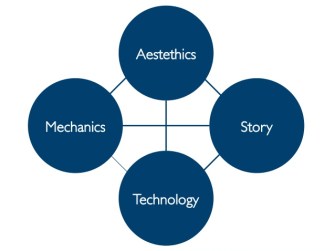We all play games and we all enjoy the time spent doing so. But as a game designer you must deeply understand what a game is made of. Before doing so, let’z ask ourselves one of the most discussed questions in the game design world: what is a game?
What is a game?
I must say that there isn’t a standard definition for what a game is, specially if we intend game as the most general abstraction of the word. But one of the definition that I like most it’s the following:
“A game is a problem-solving activity, approached with a playful attitude”.
From the book “the art of game design“
Think about this definition, every game in this world will almost certainly fit into it, for example chess, soccer and world of warcraft are all games, even if they are completely different in the way they are played and conceived. But each of these games are for sure a problem solving activity;
Soccer: witch is the best way to put the ball into the door?
Chess: How can I defeat my opponent by checkmate his king?
World of warcraft: Reaching the maximum level and be the best.
To achieve your goals in all of these games, you usually have a playful attitude and this is what makes them games and not normal task. Sometimes we refer to games as a “fun” activity to do, which is different from having a playful attitude. Fun it’s subjective: you can play a soccer match without having fun, but you are still doing it with a playful attitude and so you are playing a game without having fun. Loading a washing machine can be a game, your problem it’s to load the washing machine, it’s not a fun problem to solve but you can turn it into a game by set a simple rule: “Throw your dirty clothes into the washing machine maintaining a distance of 3 meters”. By doing so your are turning what is considered a common daily routine into a game, which can still not be fun, but thanks to that simple rule, we turn that task into a game that can be not fun but thanks to the playful attitude that have to achieve the main goal, we can definitely say that we are playing a game.
What is a game made of?

Let’s go deep into the core of the video games and try to understand what we can find inside every video game on this planet. There are 4 elements that you will always find in each game: Aesthetics, Story, Technology and Mechanics
Aesthetics: Aesthetics is the closest layer to the player. This is how your game will look to the eyes of the player, this layer will give the player the feeling of your game experience, what the player will see, what the player will hear and in general the taste of your game. Because this layer it’s in direct contact with the player, it’s one of the most important layer and can be very helpful to build the bridge from the experience that you have in your mind and what the player will really play and feel.
Mechanics: Mechanics are the rules of your game. Those define what the player can and cannot do inside your game and the goals to achieve. The mechanics of your game will use the technology to define those rules, if we are speaking about video games, you will use the technology to define the set of rules and restriction of your games, usually by writing code. But you will also use the aesthetics to enforce and emphasize those roule to the eyes of the player. When you see game tutorial, it is basically the use of the technology and the aesthetics to show the player the rules of the game, or in other words what he can and cannot do inside your game.
Story: The story is the sequence of events that unfolds in your game. Videogames have the enormous advantage to make story interactive and give the player the feeling that he choose what to do inside that story. Aesthetics will be used to show the story to the players, and the mechanics will be used to enforce the story itself. In mobile games there is usually a lack of story due to the fact that mobiles phones have a limited calculation capacity and mobile players are casual players which can be a limit if you want to tell a complex story that demand a huge amount of attention for a long period of time to the player.
Technology: Technology can be whatever tools you can use to make games. Not just high tech pc’s, but also paper, plastic, pencil etc etc. Technology is the base layer where the aesthetics take place, the mechanics will be defined and the story will be told.
from the book: THE ELEMENTAL TETRAD (ADAPTED FROM SCHELL 2008)
Conclusion:
Those layers are the core of every game, you can find those in both board games and video games. We must say that every layer has his importance and none it’s more important than the others. You as a game designer should think and take care of each one of these layer.
Ask yourself these questions:
- How are each of these layers implemented in my game?
- Can I improve some of the elements in my game that are inside these categories?
- Are all four elements well balanced?
- If not, how can I improve the balance between these layers?





Thank you Marco for the useful information you’ve shared 😉